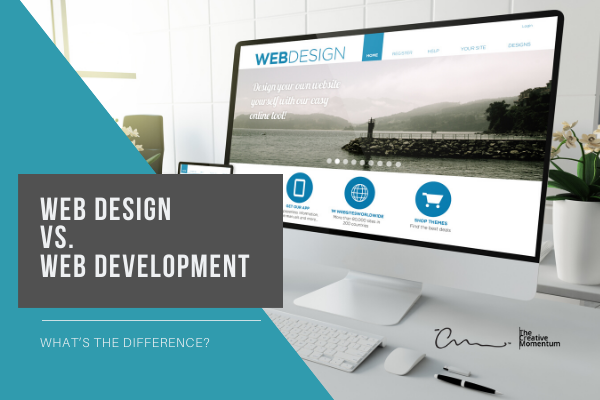
The public's understanding of websites, the internet, and digital marketing has come a long way over the past few years. We’re more tech-savvy than ever before—so why is there still so much confusion surrounding the world of website design?
We’ve seen people request a “web designer” to tackle broken elements in the CSS codebase, or when they want a fresh look for their website, they’ll ask to “get a developer” on it. Some of this confusion is understandable, given the overlapping nature of these roles, but when it comes to actually putting these ideas into practice, there’s plenty of distinction between the two.
What is Web Design?
Web design is a broad term that refers to the aesthetics and usability of a given website. In other words, it influences what users see when they look at their devices and how they’ll interact with those pages upon visiting.
In most cases, web design has more to do with the superficial elements of the website than its inner workings. Site layout, typography, color choices, location of branding elements, and the placement of on-site navigation are all elements to consider, here. Good web designers incorporate elements of visual design (such as color, line, balance, space, and so on) to create stunning visual experiences for their clients.
But there’s more to web design than just putting together a page. A thorough web design process involves reviewing the structure of the site, from initial wireframing to storyboarding to the layout of the site assets themselves. (We’ll get into development in just a minute, where these choices will be implemented—but in the early stages, web designers use their knowledge of visual design to help put things together.)
In short, when someone says they want a “good looking website,” web designers are the ones to call. But aesthetics are only part of a designer’s job. The aesthetic functions of a website—while important in their own right—are usually done in service of a larger purpose, which is to create a great user experience (UX) for visitors. This is where the “usability” side of things comes into play.
Design elements such as site layout, navigation, and the way visuals coordinate can have a big impact on the user’s perception of the site and how they’ll end up using it. In fact, many designers these days style themselves as “experiential designers” or “UX designers” due to just how important these usability elements are.
What is Web Development?
If design is all about visioning the ideal form of a website, development is about putting that plan into action. Web development involves applying specific styles of programming and code to bring website pages to life and ensure that all site elements work as they should.
But just like web design, the term “web development” can encompass a broad range of goals and strategies. Typically, web development is split into two buckets: frontend and backend development.
Frontend developers are directly responsible for creating the user interface (UI) developed in the early stages of web design. They’ll tap into programming languages like CSS, HTML, and JavaScript to build an interface that pulls data from the other side—the backend—to be displayed for visitors.
Conversely, backend development involves the hidden, inner workings of the website that visitors never see. These developers leverage many of the same programming tools as frontend developers, only applied to the cogs and gears of the website to produce specific functionalities for website visitors. Typically, these functions are produced by integrating various application programming interfaces (APIs), software, and frameworks into the development stack to produce outcomes—for example, adding an eCommerce shopping cart to a website, or integrating email capture form fields to support marketing data collection.
It’s crucial that backend developers coordinate work carefully with frontend teams and anyone else involved in their projects, as there’s a lot of variance in how backend programming can be set up. Sloppy developers may be able to put together a site that’s functional—but it might be slow to load, unresponsive, or contain broken elements that interfere with the website’s goals.
Of course, the development side of things is no more or less important than the initial design stages, but as development is the point where rubber meets road, so to speak, it’s crucial that website owners have a good system for putting their goals into action.
Synergizing the Two Disciplines
We’ve outlined some big distinctions between the web design and web development disciplines, but at the end of the day, their purpose is the same: building an appealing website that meets the client’s goals and speaks to the client’s market.
As such, it’s easy to see how the two synergize. Simple and straightforward web design layouts are easier to develop than large, sprawling behemoths—and every development choice made behind the scenes will affect how the visual elements are presented. The two go hand-in-hand, and you can’t have one without the other.
And these days, both developers and designers understand this and are blending their skillsets accordingly. It’s becoming increasingly common to see developers with some experience in wireframing and storyboarding, just as it’s common to see web designers getting familiar with HTML and CSS. In fact, thanks to the wealth of educational resources available online these days, we’re seeing more and more developers take an integrated approach to their skillsets to encompass all aspects of frontend development and visual web design. This type of programmer can manage projects from end-to-end, taking a website all the way from its early design to a live, final product.
Naturally, these types of developers are desirable in the marketplace—and while the steps to achieving this level of skills is beyond the scope of this piece, it illustrates just how closely integrated the development and design aspects of website creation have become.
The Distinctions Are Fading
Over time, we expect to see the distinctions between these key roles to fade even further. There’s already a bit of overlap between the two roles, and those who understand the nuances of each discipline will be better prepared to tackle design and development issues on either side of the fence. When we put everything else aside, the two disciplines share much in common and are done with the same goal in mind: Use the assets at our disposal to create an effective and well-functioning website.


